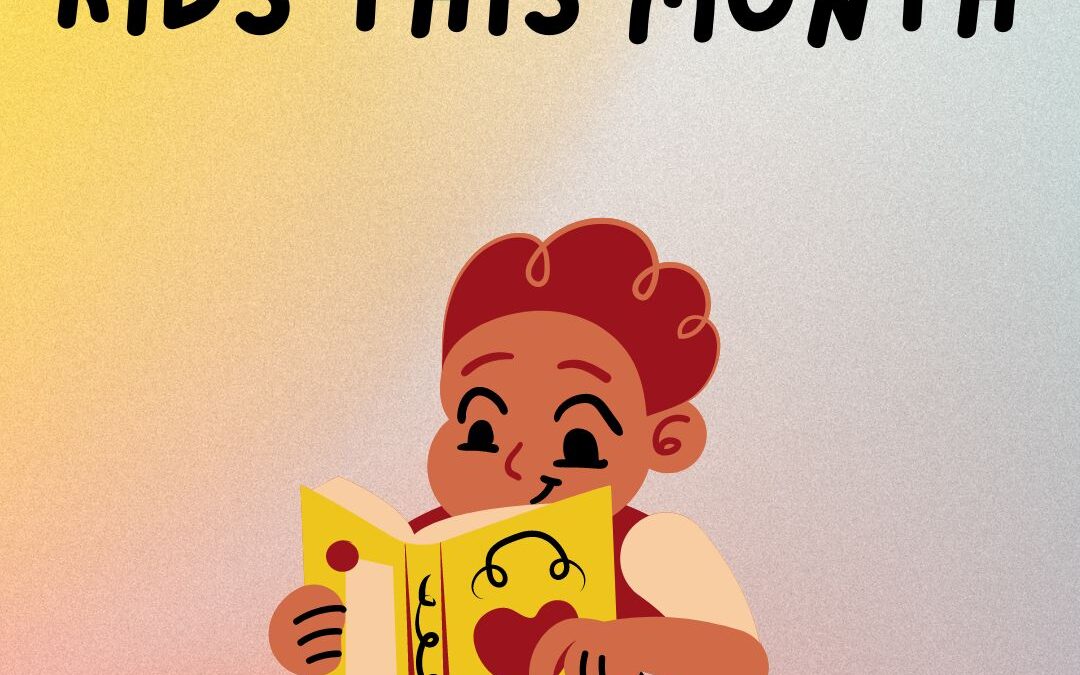
by Sneha Sharma | Jun 2, 2023 | Children's Literature
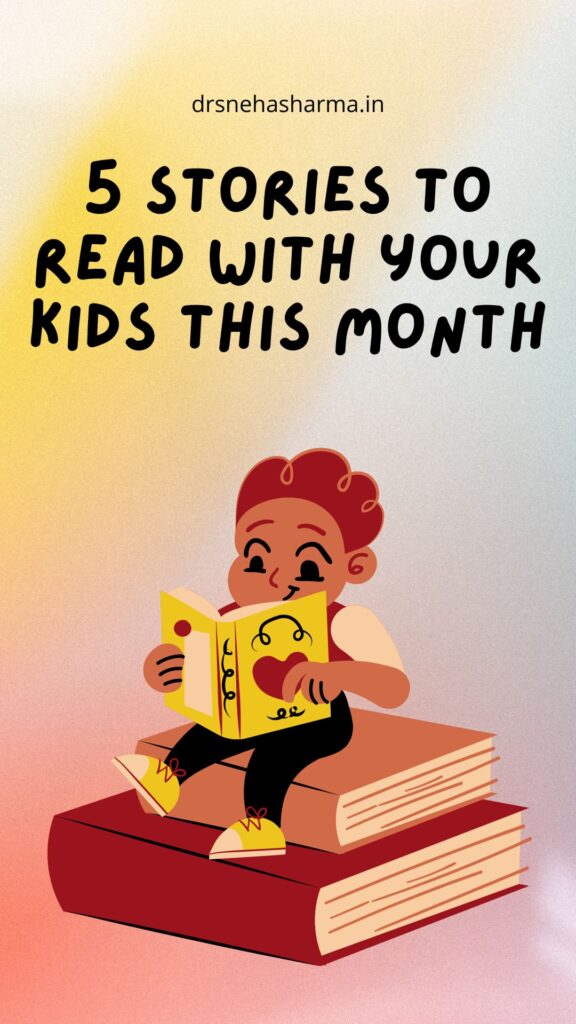
Ok. First things first. Let me tell you, the short list of books here is a choice based on my authentic review. I and my children have not only read these books but loved them throughout our reading journey. There are books we have read popular enough to recommend to you, but I am not willing to list them here just for the sake of it and simply because we didn’t enjoy them!
It would be advisable to ask children after every 10 pages of the book they are reading, if they are really enjoying it. Because the idea here is to motivate them to read more, not bombard them with stories they don’t enjoy.
So here’s my list of the month –
- Matilda – By Roald Dahl
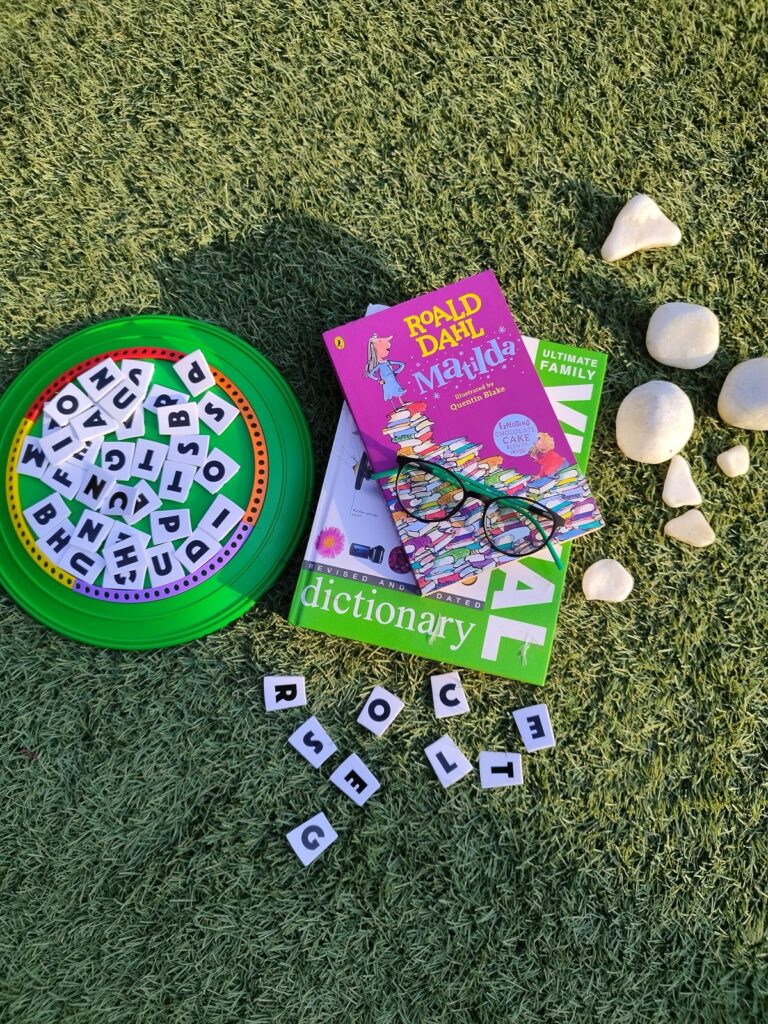
Enter the courageous world of this child prodigy with no less a thrill than one can expect from a Tom Sawyer story or Chronicles of Narnia. We might think the girl hero was lucky to have the ‘parfait’ brain of a genius, but her courage..her courage was a gift with no extraordinary tag..it was simply the one we all possess naturally!
And then you love the dialogues, especially Agatha Tunchbull’s. They probably come from Roald Dahl’s real-life school experiences with his harsh headmasters as he vividly narrates in his autobiography ‘Boy’!
A story worth reading twice, for the fun it promises and for its true-to-world characters!
Age Rating – 4-6 years.
- Gauri and the Talking Cow – Devdutt Pattanaik
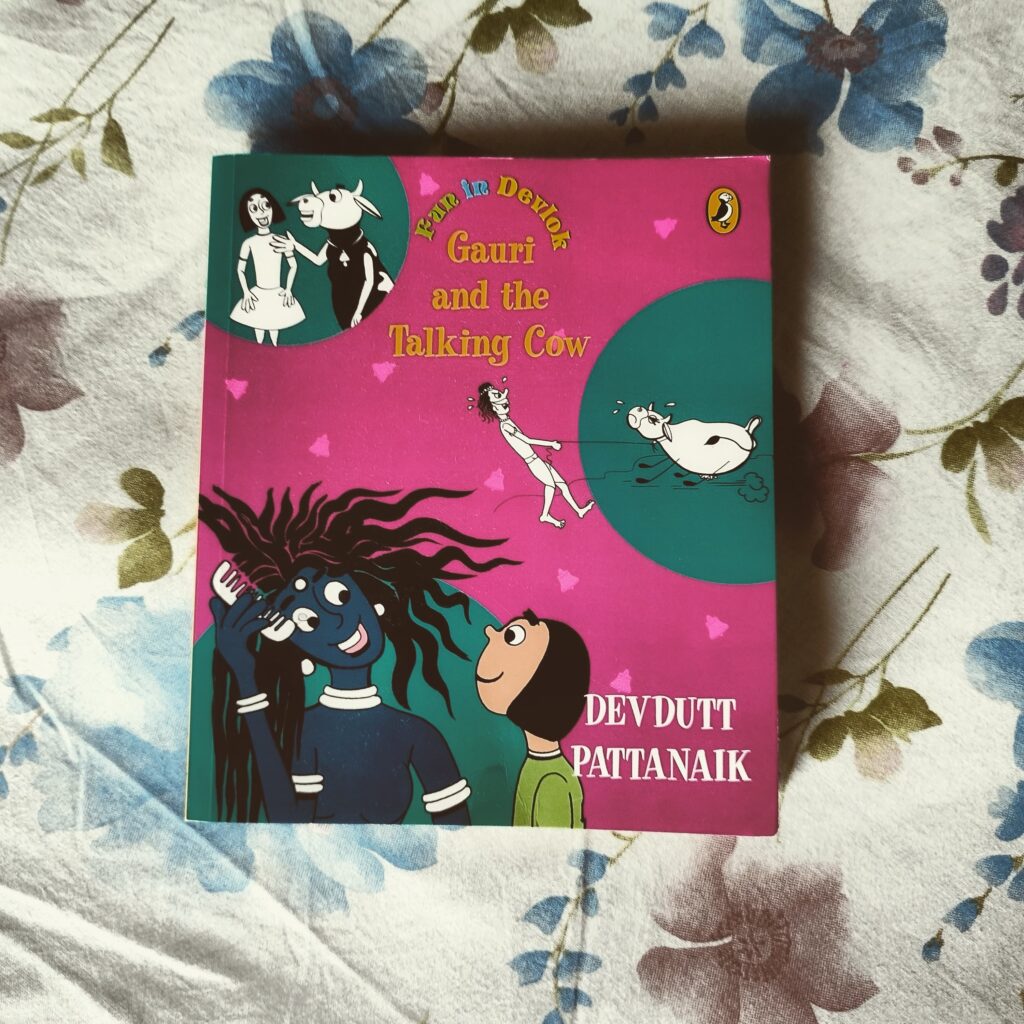
Here’s some Indian reading from our own mythologist Devdutt Pattanaik.
‘Kali’ – is for the wild, the scary forest-like..’Gauri’ – is for the garden, safe and domestic..they are the names of the same goddess in her different ‘avatars’..
As Sweety the talking cow narrates the story of Kali to Gauri, a girl who visits her village with her father, we know we are in for an amusing, informative and interesting tale.
My son and I loved the monochrome cartoon drawing assisting the text. The best part of the story was when Sweety narrates the tales of Raja Indradyumna and Raja Nruga both teaching two different aspects of good and bad conducts.
Couldn’t fathom why in Indradyumna’s story, Gods condition his stay in heaven on finding someone on earth who still remembers his good conduct. But as the author Devdutt Patnaik tells how stories, symbols and rituals construct the subjective truth (myths) of ancient and modern cultures around the world, in order to dive deep into it and abstract its true meaning, it’s advisable to explore the multiple layers of that truth. But at least stories like these trigger the essential curiosity in children that would turn their inclination towards the cultural myths and discover the real truth behind them.
Age Rating – 6-10 years
- Miss Rumphius’ by Barbara Cooney
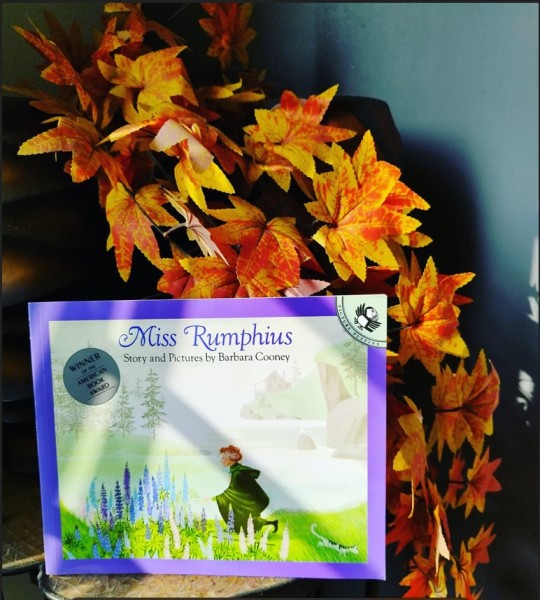
An article published in The Atlantic, titled ‘What Would Miss Rumphius Do’ in 2017, led me to buy this picturesque storybook for my children. ‘The Lupine Lady’ has become a household name since.
The beautifully painted characters and the lupines in different shades of blue and pink spread elegantly across the landscape pages of the book, sparkle like diamonds. The fact that it is a true story makes the protagonist even more lovable.
It concocts some unique takeaways for kids – we can all make the world beautiful in our own unique style and it starts with small consistent steps
And..
It’s important to take breaks and embrace boredom – as it was during one such phase when Ms. Rumphius carves out a way to fulfilling her grandfather’s wish, which was her dream too – ‘To make the world more beautiful than it already is.’
What does she do to make her dream true?
Find out in this beautiful story of ‘Miss Rumphius’ by Barbara Cooney
Age Rating – 6 – 10
Here are some helpful resources you can help your child with post reading the story.
https://www.prindleinstitute.org/books/miss-rumphius/
https://www.theatlantic.com/magazine/archive/2017/12/childrens-books-for-uncertain-times/544104/
- Timmy in Tangles by Shals Mahajan
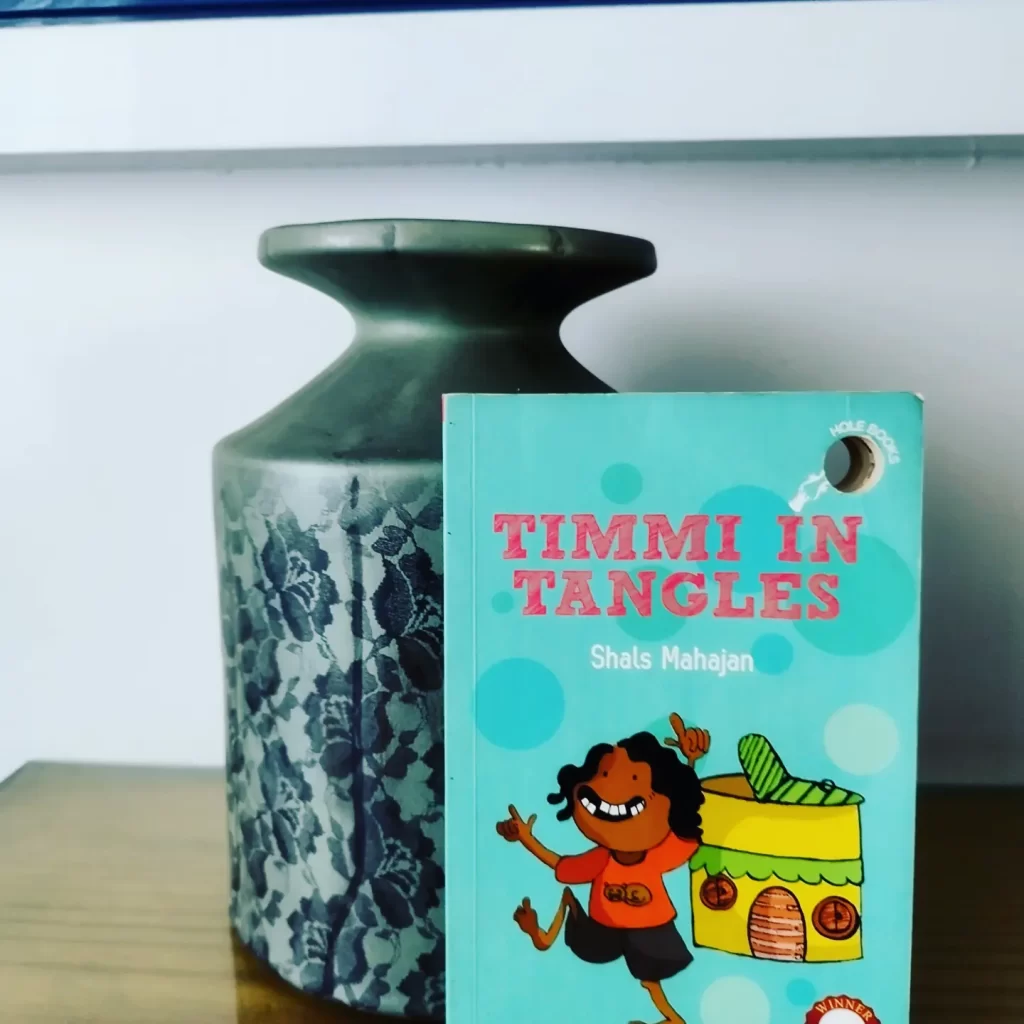
As a self-read, this handy 70-page book by Duckbill is the right fit for a light-hearted read during that extra time in the lunch-break or for quickly making those yawning fits disappear during class breaks.
I loved the illustrations by Shreya Sen, just the perfect support for the kids to enter into Timmy’s world.
Shals Mahajan takes children in the small but engaging world of Timmy, where she creates and befriends characters out of her own splendid imagination, who have been Indianized in a way it seems they actually reside somewhere in our surrounding. While to adults they might seem too strange and conceptually unidentifiable, surprisingly, they work too well with the kids. They quickly begin to see them with the eyes of Timmy!
My favourites – ‘Kichoo the cockroach’, playing a cameo but his dreaded long-‘mooch’-tickling is enough to compensate for the rest of his absence.
My 6-year-old, Anhad’s favourite character – ‘Idli Amma’ as she too loves Idlis like him and feeds on story food!
And how about ‘hanging’ a book by the bedside? I do that with the signature hole in the corner of these duckbill books!
Age rating – 5-9 years
- The Velveteen Rabbit by Margery Williams
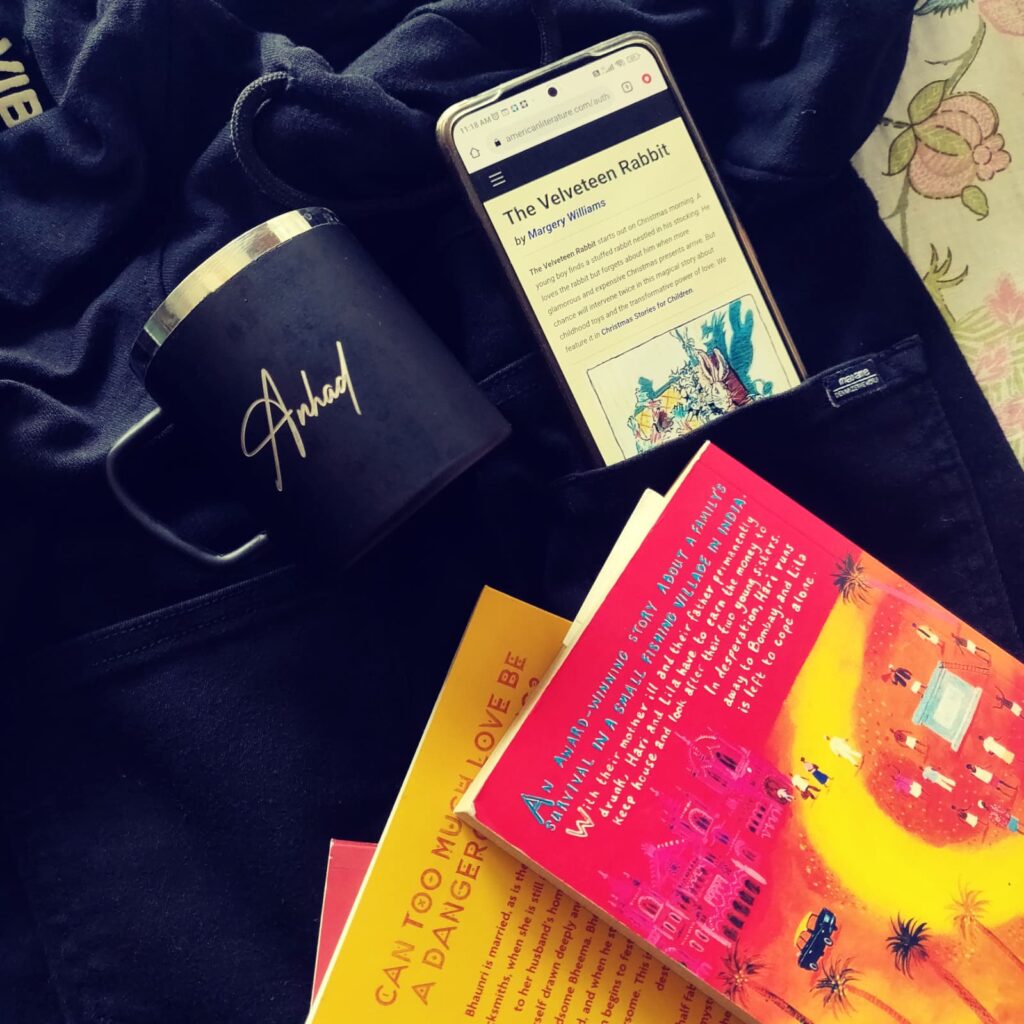
Excerpt from the story –
“What is REAL?” asked the Rabbit one day, when they were lying side by side near the nursery fender, before Nana came to tidy the room. “Does it mean having things that buzz inside you and a stick-out handle?”
“Real isn’t how you are made,” said the Skin Horse. “It’s a thing that happens to you. When a child loves you for a long, long time, not just to play with, but REALLY loves you, then you become Real.”
“Does it hurt?” asked the Rabbit.
“Sometimes,” said the Skin Horse, for he was always truthful. “When you are Real you don’t mind being hurt.”
“Does it happen all at once, like being wound up,” he asked, “or bit by bit?”
No.. It takes a long time. That’s why it doesn’t often happen to people who break easily, or have sharp edges, or who have to be carefully kept, answered the skin horse.
******
Can the concept of love be more beautifully interposed with children than this? This story of love spoken from the perspective of a toy velvet rabbit blurs out the world outside and spotlights the two characters of the rabbit being loved so whole-heartedly in the most passionate, purest form of love that it comes to life – from the toy world to human, and the distant but familiar character of the young boy who loves his toy rabbit unconditionally!
The rabbit waits for the day when the boy chooses him as his playmate and wants to be a REAL rabbit to be able to LIVE with the boy he loves forever.
It intrigues children to think philosophically about what is ‘real’ – a physical form, being loved enough that makes us real, or being present in flesh and blood.
And then it answers very subtly – that a physical form is not being real, being in flesh and blood isn’t reality alone but being LOVED ENOUGH is!
What makes you real?
The capacity to love and be loved enough!
*****
While this is a personal round-up of books to read with your child this June, there are lots to explore from the Indian English and Hindi books as well.
by Sneha Sharma | May 7, 2022 | Creative Writing Tips
Voice in writing
Having a clearly defined literary voice can have a timeless appeal. In a piece of fiction, voice can mean –
- Author’s voice,
- Character’s voice and
- Narrator’s voice.
The Narrator’s voice –
The narrator is the ‘all-seeing eye’ of a story. In a case where there can be no specific attribute or name given to the narrator (Hills like White Elephants by Earnest Hemmingway), it can still have that omniscient point-of-view or POV, which can access characters’ feelings and thoughts and knows where the story is taking the reader. The narrator’s voice is the voice of the character or personality narrating the story. This voice can be different from the author’s voice, unless the author is narrating the story herself, like in case of personal essays, where she would consciously try to reveal her style of writing to the reader and would like to adopt an honest, natural tone to stay as close to her own personality as possible. While doing this, she would also understand how this style of writing relates to her audience.
So, narrator’s voice is the voice of the person telling the story. Just like in a Radio drama, we are able to tell the character’s voice from the narrator’s voice, while reading fiction, we can discern the same. We can tell one voice from the other. The narrator will have his own set of diction, mood and style of telling the story and can take a particular POV (Point of View.), different from the Author’s.
Character’s voice –
A story can have multiple character voices. A character’s voice tells us about their personality, disposition (characteristic attitude) and background. In a story every character has their own way of expression. He may sound casual or cautious, terse or verbose, traits revealed by the way they use words and react in a dialogue or scene.
The precise elements that may be studied to understand a character’s voice are their –
- Tone
- Diction
- Dialect
- Level of introversion or extroversion
These elements may also reveal their age, nationality or life experiences.
For example, in E.B. White’s Charollete’s Web, Charollete, the female spider is like an old teacher with a caring and selfless demeanor when she speaks to Wilbur, the pig. She speaks with clarity and there’s an inspirational slant in her language.
“These autumn days will shorten and grow cold. The leaves will shake loose from the trees and fall. Christmas will come, then the snows of winter. You will live to enjoy the beauty of the frozen world, for you mean a great deal to Zuckerman and he will not harm you, ever. Winter will pass, the days will lengthen, the ice will melt in the pasture pond. The song sparrow will return and sing, the frogs will awake, the warm wind will blow again. All these sights and sounds and smells will be yours to enjoy, Wilbur — this lovely world, these precious days…”
- Charollete, from Charollete’s Web.
Wilbur, on the other hand is diffident and low in self-esteem.
“But Charlotte,” said Wilbur, “I’m not terrific.” – Wilbur (when Charollete decides to spin the word ‘Terrific’ through her web, for the him.)
Author’s Voice
The author’s voice is her personality coming through on the page. It includes everything from her tone (attitude towards a problem), her word choice or diction, punctuation and sentence structure. Her thoughts, part of her voice, are also conveyed through the voices of her characters and their background like age, nationality etc.
An example of voice could be the long, crafty sentences of Dickens or, cut to the chase sentences (without much use of adverbs) of Hemmingway.
An author’s voice is also determined by –
- Mood
- Or worldview
- Point of View
Voice of the following authors transcends their individual work –
- Earnest Hemmingway
- Toni Morrison
- James Joyce
- Joyce Oates
- Margret Atwood
- Nathaniel Hawthorne
Meaning of the worldview –
Every author has a picture they paint of the world. There’s a certain way they think about the world according to their own values, experiences and learnings. A worldview or perspective, is what an author thinks about worldly topics like – love, family, terrorism etc. and this can be narrated through the characters in fiction and through first or second person point of view in case of Non-fiction.
For example, if I am standing facing the façade of a large building and if I were to tell somebody how the building looks, I would give the description of the facade. It’s like seeing something from one angle and only talking about that angle in detail. Like talking from a young man’s perspective, the story might take us into different action-oriented scenes, making us feel that life is really adventurous, and from an old man’s perspective it might be more observational and analytical.
by Sneha Sharma | Dec 18, 2021 | Children's Literature
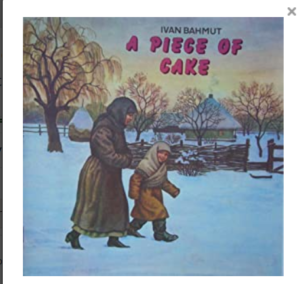
During Diwali vacations this winter, I found in my old library, the book I had so much cherished as a child. It was the story, my father read out to me when I would be tucked in bed or laze on the drawing room sofa, or simply when I demanded.
A Ukrainian folk tale, the book belongs to one of my brilliant memories of story listening experience from my parents, when I was a child and it is a treasure, I would forever behold.
The book ‘A Piece of Cake’ written by Ivan Bahmut, is a story (that runs in flashback), of a little boy named Mikolko, who is happy to be invited over for a dinner party at his Aunt’s. He’s happy also because he gets to wear his father’s shoes. His own, are torn. Mother instructs him to behave gentlemanly and not to gorge on the food Aunt Kalyan serves to him, as they are poor and might be made fun of by the arrogant Aunt; a point which the innocent Mikolko does not completely fathom.
Going by his mother’s instructions, when finally, the children are served dessert – a cake, Mikolko takes only a piece when insisted. When he tries to have a second helping, mother catches him in the act and so does his Aunt. To save his mother the embarrassment, he makes an excuse, that it was the cat he was feeding the cake to! When Aunty tries to humiliate him further by saying how could a cat eat a cake, her jovial son snatches the cake from Mikolko’s hand and feeds it to the cat, who relishes it like anything.
The Aunt stands sullen faced and openly shows disregard for Mikolko and his father, calling him a thief, while Mikolko’s mother cries tears of pride and love on the pleasurable discovery of his son’s mature understanding.
The description of mother’s fear of humiliation and being called out for her poverty, earlier in the story and during the dinner party are natural, real, touchy, naïve and painful.
The book although mentioned in the Goodreads, does not have much literature about either the story or the author. This is unfortunate, because the folklore shows us how children interpret the essential emotions and feelings, like embarrassment and pride, reflected through their parents’ non-verbal expressions, instead of directly experiencing them.
by Sneha Sharma | Oct 23, 2021 | Book Discussions
I read ‘The Cat Person’ posted on New Yorker sometime back and it’s a story you feel compelled to read in one go. I liked it because it was contemporary, realistic and feminist. In spite of its American setting/backdrop, it had a universal appeal. The theme was loud and clear – The power imbalance between older men and younger women dating each other.
It also highlights the concept of consensual sex – how there can still be elements of emotional molestation and superiority and subjugation, falling heavy on female assertiveness.
There were layers of following sub-themes too –
- Dynamics of coercion
- the highly manipulative and self-delusionary phase of early courtship,
Margot is scared of being judged by her boyfriend. She is aware of the storm that would follow if she breaks up with him on the grounds of bad sex. To her horror, the guy does not take the rejection on a casual note and abuses her verbally, pestering her, flooding her phone with mean messaging! No matter how much we advance in this constantly changing landscape of technology, space and astronomy, our fundamentals of a happy survival remain flawed, which starts with the relationship with the women around us.
A young woman in the age of her so-called independence, belonging to the era past feminism and modernism, still feels savaged and besotted by the technology and her relationship with a man.
Other facts about “Cat Person” by Kristen Roupenian –
Cat Person went on to get more than 4.5m hits and become the most-read piece of online fiction the New Yorker has published and has also been prosecuted as part of a ‘man-hating liberal agenda’ by many on social media.
Roupenian’s short story collection – ‘You know You Want this’ has won Roupenian a reported $1.2m advance and is being adapted into an HBO series. The stories work in the theme of – ‘the extent to which men rejected by women hate women, and women rejected by men hate themselves.’
Read the story here –
https://www.newyorker.com/magazine/2017/12/11/cat-person
Suggested Reading –
https://www.theguardian.com/books/2019/jan/26/cat-person-author-kristen-roupenian-dating-ego-power-control
https://www.washingtonpost.com/news/soloish/wp/2017/12/12/why-cat-person-a-new-yorker-short-story-is-essential-reading-for-this-metoo-moment/ –

by Sneha Sharma | Sep 6, 2021 | Book Discussions
A Room of One’s Own by VIRGINIA WOOLF
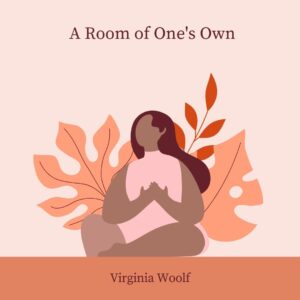
What is the book all about?
Following a mentor’s suggestion to read autobiographies/memoir of the heroes to capture the intricacies of their lives and learn the lessons they did the hard way, I came across ‘Room of one’s own’ – which wasn’t autobiographical but rather a literary critical essay on women fiction writers during 1920s. It falls under highly recommended reading for artists, literature history lovers, students of English literature, women writers and in general for all those simply needing an inspiration to write. Virginia Woolf, after a thorough research on women and fiction wrote this book as a ‘stream of consciousness.’
Why read it in today’s times?
As a piece of feminist writing, focusing on the problems of a woman writer belonging to a previous era, is the book worth reading?
Woolf’s use of language and intelligence has been highly influential on English literature and she is one of the foremost modernist literary figures of the twentieth century. For the writers learning to polish their strokes, not only reading but a study of some of Woolf’s work certainly proves valuable.
This book in particular talks about the genius of Bronte sisters, about English novelist George Eliot, how brilliant these writers were to be able to perform and produce sheer pieces of brilliance, working in extreme constraints, even hiding the fact that they were writing fiction, frightened to express their fondness towards the art, covered their writing with a blotting, for the shame of wasting their time with “scribbles” being a woman (as Jane Austen did whenever someone came into the common room), wrote in the living room with thousand practical distractions, ten children to look after, as the line was so predominantly considered a male profession.
George Eliot had to write under a male title for acceptance of her work. These harsh facts open our eyes to the atrocities that women writers and women in general faced as a fairer sex in Woolf’s era and prior. As an Asian community, the revelations surprise us because for us the West has always stood for freedom, expression and liberty and the violence and injustice done to women even if in a different era, the kind still prevalent in Indian societies, makes the read relevant enough for the artists and their male and female counterparts.
A female writers’ essential space
With the imaginary example of William Shakespeare’s sister, assuming she is equally talented as him, Woolf reasons, it’s not the difference of physical strength that had led historically, more work of writing from men than women. Her analysis of old literature and the basic gender roles discovers that men are at an advantage of space, money and education. In her quest to conquer the literary world of 16th century, this imaginary character of Shakespeare’s sister is blocked at every step by the society for being a female aspirant of writing.
So, it raises a point that for such female aspirants of writing, independence and solitude are essential for artistic creation. She needs a room of her own, money to buy herself that and a lock on the door.
The Conclusion
The conclusion of the book does satisfy the believers of feminism –
“It would be a thousand pities if women wrote like men, or lived like men, or looked like men, for if two sexes are quite inadequate, considering the vastness and variety of the world, how should we manage with one only? Ought not education to bring out and fortify the differences rather than the similarities?”
She also concludes that each human has a multifaceted personality and that each artist must draw from both male and female parts of the mind.
“In each of us two powers preside, one male, one female… The androgynous mind is resonant and porous… naturally creative, incandescent and undivided.
And most importantly she insists to write freely without any fear of judgement.
Relevance of the text to a modern female writer
Apparently what appears to be a minor attribute – having a space of one’s own, raised in the context of women writers’ quintessential need, something that a modern female writer might choose to laugh at -becomes a thought of serious consequence.
The space here has metaphorical context of literal-physical and mental arrangement a woman needs to write well. She needs to be free from the anxiety about the eligibility and trustworthiness of that ‘someone’ who is looking after her kids and household while she writes, at least till the time her children become independent. That’s when she can completely surrender to the world of her creative abilities and the magic it begets. A modern female writer too cannot choose to laugh at this one after all, as the problem is still very much relevant for her.
My personal account
When I wrote only as a hobby, I had to many times hide the fact that I am writing for the fear of being caught in doing something menial, something that is not paying one in money. I waited for the room to be empty as directly telling someone to leave for my writing in private, might be considered hysterical. I couldn’t design my own time and in stead my time of writing was decided at the mercy of others. I never openly discussed with my family how writing relieves me and is so beyond a hobby. When I started writing for Times and took to teaching as a job, many times in the alibi of working for my employers, I wrote my heart out. My excuse was now eligible for consideration.
Few years back although, during one of our evening walks, I explained to my husband and my sister, how imagining my routine days without some pleasure writing, would be difficult for me and how the regret would hover around when I am older, they took my earnest appeal in consideration and not only could I make time for doing what I loved to do but stood tall with motivation (motivation was never something I thought I would be needing so much because of the lapse in practice!).
While it might not be so simple for many other female counterparts, it still makes sense to discuss about one’s passions and desire to pursue a hobby, and if it is writing, about the ‘space’ one very much needs for her muse.
This book can give confidence to so many women wanting to express their unheard voices through their ink.
Suggested Further reading –
Analysis of Virginia Woolf’s A Room of One’s Own










